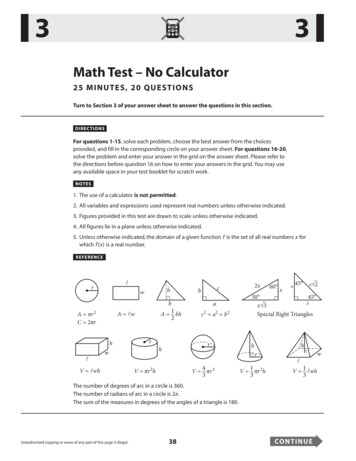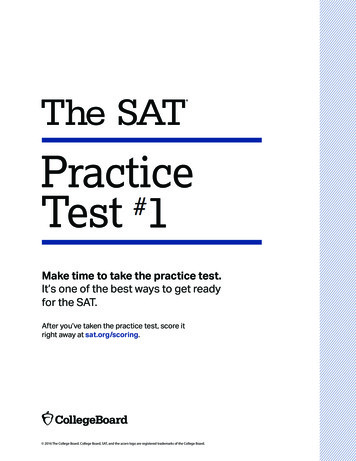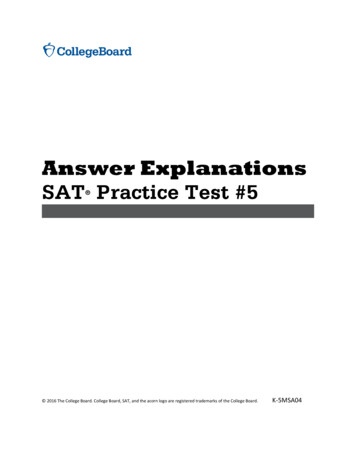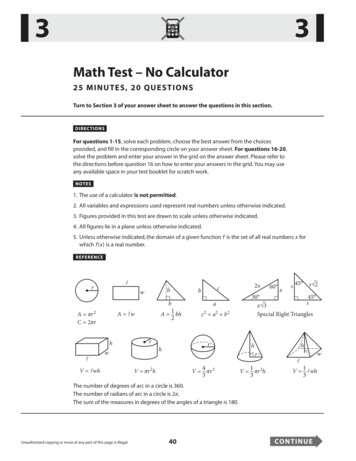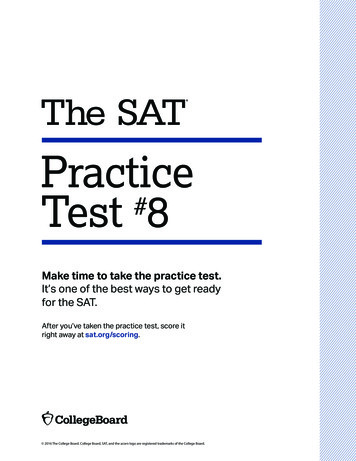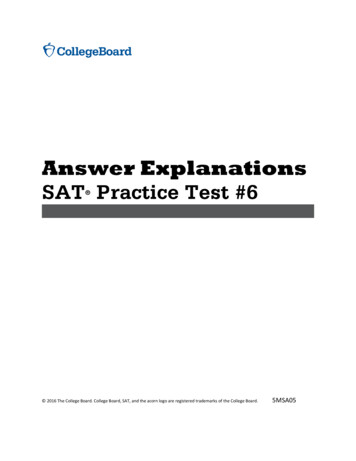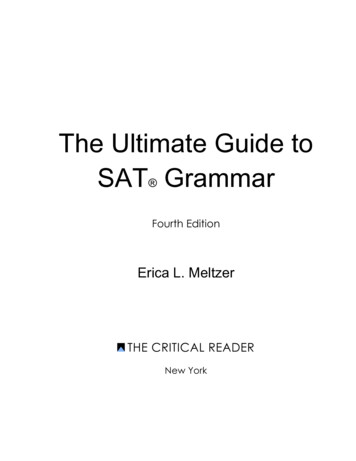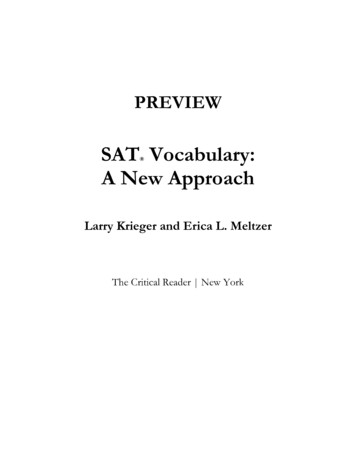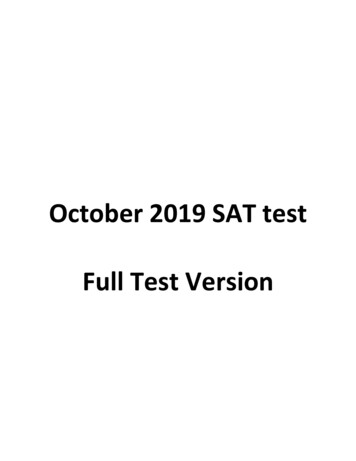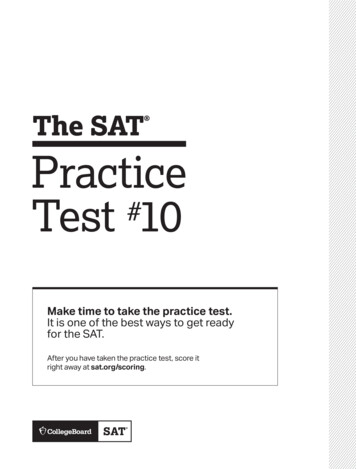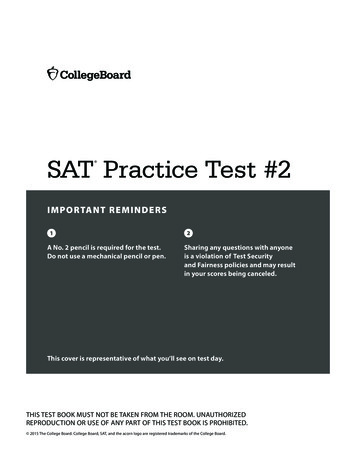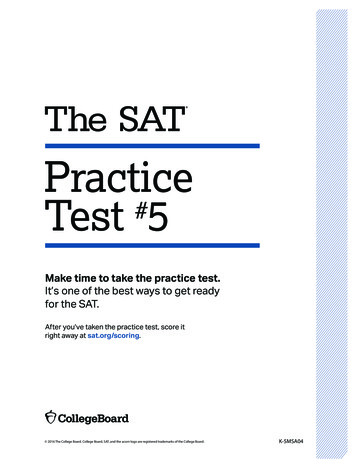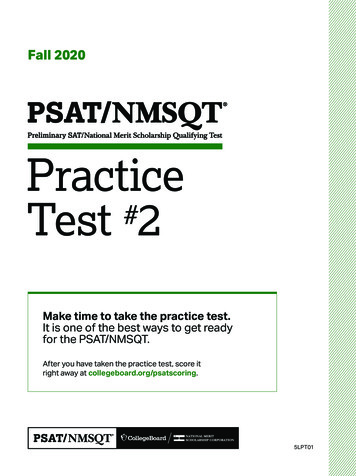
Transcription
Fall 2020Practice#Test 2Make time to take the practice test.It is one of the best ways to get readyfor the PSAT/NMSQT.After you have taken the practice test, score itright away at collegeboard.org/psatscoring.5LPT01
Take the Practice Test Get Credit for All You KnowTake the Practice TestTake the practice test on the following pages tobecome familiar with the kinds of questions on thePSAT/NMSQT . The test you take in the fall willcontain the same four sections as this practice test:(1) a Reading Test, (2) a Writing and Language Test,(3) a portion of the Math Test on which a calculatoris not allowed, and (4) a portion of the Math Test onwhich a calculator is allowed.NOTE: This is Practice Test #2. For Practice Test #1,as well as practice tests in MP3 audio and otherformats, go to collegeboard.org/psatpractice. Youcan also call 212-713-8333 to request a practice testin specific formats.Set aside about 3 hours to take the entire test (thisincludes two breaks), and use the practice answersheet on page 3. Have your calculator available onlyfor the Math Test – Calculator section. Afterthe test, check your answers to see how you scored.Get Credit for All You Know Use a No. 2 pencil. See “Marking Answers” below for instructionson marking your answer sheet.Test-Taking StrategiesTry these out when you take the practice test: Focus on easy questions first. You receive onepoint for each correct answer, no matter howhard or easy the question is. Work steadily. Use a watch to help with pacing.Don’t waste time on a question that is hard foryou. If you cannot answer it, mark it in your testbook and go on. Go back to it later if there is time. It’s okay to guess (see “Guessing” below). Mark your answers in the correct row on theanswer sheet. Be especially careful if you skipquestions. For Math Test – No Calculator questions 14–17and Math Test – Calculator questions 28–31,first write your answer in the boxes above thebubbles, and then grid your answer accuratelyand as completely as the grid will accommodate.If you mark incorrect bubbles, the answer willbe scored as incorrect, even if the right answeris given in the boxes. Double-check your gridsto ensure that you haven’t marked more thanone bubble in the same column.You don’t have to get every question right. Youcan do well even if you answer some questionsincorrectly.STANDARD TIMINGReading Test:60 minutesWriting and Language Test: 35 minutesMath Test – No Calculator:Math Test – Calculator:SCORINGGUESSINGEach correct answer:Wrong/blank answers:One pointNo points lost25 minutes45 minutesThere is no penalty for wrong answers, so itmakes sense to give the best answer you can toevery question, even if it is just your best guess.MARKING ANSWERSMake sure each mark is dark and completely fills the bubble. If you erase, do so completely. You may usethe test book for scratch work, but for the actual test you will not receive credit for anything you write there.CHECKING ANSWERSWhen you take the test, you may check yourbefore time is called, but you may not turn toany other section.22020 PSAT/NMSQTPractice Test #2For information on how toscore your practice test, go to:collegeboard.org/psatpractice
eticacPrPractice Test #2 2020 PSAT/NMSQT3
42020 PSAT/NMSQTPractice Test #2
11Reading Test6 0 M I NU TES, 4 7 QUESTIONSTurn to Section 1 of your answer sheet to answer the questions in this section.Each passage or pair of passages below is followed by a number of questions. After readingeach passage or pair, choose the best answer to each question based on what is stated orimplied in the passage or passages and in any accompanying graphics (such as a table orgraph).This passage is adapted from Mark Slouka, Brewster: A Novel. 2013 by Mark Slouka.Line510152025This was a time trial, he said—a one-mile timetrial, four laps—not a race. It was meant to give anidea of where we stood, no more.We’d gathered around the middle of the long sideof the track, just ten or twelve of us, including threeothers who seemed new like me, jogging back andforth in the wind, loosening up. The rest had walkedover to the other side of the field.Falvo took me aside. “Warmed up? How’re theshoes?”“Fine.” In the distance I could see kids walkingtoward the parking lot. The sun stabbed out fromunder the clouds, glancing off the windshields.He raised his voice over the wind. “All right, Iwant you all to stay contained, stay smooth. I don’twant to see anybody draining the well today—thatmeans you, Mr. McCann.” A tall, tough-looking kidwith red hair and a tight face smiled like a gunslinger.He turned to me. “I don’t want you doinganything stupid, Mosher. Some of these boys havebeen at it for a while. Don’t think about them, thinkabout yourself.”I shrugged.“Pace yourself. Let them do what they do. They’llbe about thirty yards ahead after the first lap. Don’tworry about them. Go out slow, feel your way, thenbring it home as best you can. OK?”“Sure,” I said.“Remember, it’s a time trial. Not a race.”Unauthorized copying or reuse of any part of this page is illegal.Questions 1-9 are based on the following passage.530354045505560There was no starting gun. We lined up in thegusty wind, Falvo standing in the soggy infield in hisdress shoes holding his clipboard like a small hightable against his chest with his left hand and hisstopwatch in his right and then he barked, “Runners. . . marks? Go!”They didn’t run, they flowed—the kid in theheadband, the red-headed kid, and two or threeothers in particular—with a quiet, aggressive,sustained power that looked like nothing but feltlike murder and I was with them and then halfwaythrough the third turn they were moving awaysmooth as water and I could hear them talkingamong themselves, and I was slowing, burning,leaning back like there was a rope around my neck.“Too fast, Mosher, too fast,” I heard Falvo yelling,and his ax-sharp face came out of nowhere lookingalmost frantic and then it was gone and there wasjust the sound of my breathing and the crunch of mysneakers slapping the dirt. The group, still in a tightcluster, wasn’t all that far ahead of me.By the end of the second lap I heard someone faraway yelling “Stop, Mosher, that’s enough,” and thenat some point someone else calling “Comingthrough—inside,” and they passed me like a singlemass, all business now, and I remember staggeringafter them, gasping, drowning, my chest, my legs, mythroat filling with lead and looking up through a fogof pain just in time to see the kid with the headband,halfway down the backstretch, accelerating into asustained, powerful sprint.CO NTI N U E
170758085901Based on the passage, which character would mostlikely agree with the idea that, when tryingsomething new, it is best not to push one’s limits?A) FalvoB) McCannC) MosherD) The person who said “Let him go”Unauthorized copying or reuse of any part of this page is illegal.65I don’t know why. I can’t explain it. By the end ofthe third lap I was barely moving, clawing at the air,oblivious to everything except the dirt unfoldingendlessly in front of me. “Let him go,” I heardsomebody say. They’d all finished by then, recovered,and now stood watching as I staggered past them likesomething shot. “C’mon . . . ” I heard someone startto call out uneasily, and then, “What’s his name?”A small crowd, I found out later, sensing somethinggoing on, had gathered by the fence to the parkinglot. The last of the newcomers had passed melong ago.I remember seeing him appear in front of me likeI was coming up from underwater and trying toswerve but I was barely standing and I walked rightinto him and he caught me as I fell, his one good armaround my back, saying over and over, “All right,easy now, easy, you’re done, keep walking, walk itoff,” like he was gentling a horse. I threw up on theinfield grass.“What we have here,” he was saying, “is a failureto communicate. Stay within yourself, I said.Don't drain the well, I said.”“What did I get?” I couldn’t seem to hold my headup, or open my eyes—the pain kept coming in waves.“What?”“Time. What time did I get?”He laughed—that bitter Falvo laugh—ha!—likehe’d just been vindicated. “He wants to know whathe got,” he said, like there was somebody with us.“You want to know what you got? I’ll tell youwhat you got: proof you could beat yourselfsenseless—something I very much doubt youneeded.”162Which choice provides the best evidence for theanswer to the previous question?A) Lines 14-17 (“All right . . . McCann”)B) Lines 19-22 (“He turned . . . yourself”)C) Lines 55-60 (“I remember . . . sprint”)D) Lines 76-79 (“he caught . . . horse”)3In the context of Falvo’s instructions to the runners,the main purpose of lines 24-27 (“Pace . . . OK”) is toA) provide useful general information to the group.B) emphasize and elaborate on advice given earlier.C) introduce a philosophy applicable to sportsand life.D) reveal Falvo’s underlying motivation.CO NTI N U E
1In the context of the passage, “I shrugged” (line 23)and “‘Sure,’ I said” (line 28) mainly serve to show thenarrator’sA) shyness.B) dismissiveness.C) dishonesty.D) hostility.5Based on the passage, how did the experiencedrunners respond to Falvo’s advice?A) They enthusiastically embraced it.B) They acted like they hadn’t heard it.C) They generally accepted it.D) They only pretended to take it seriously.Unauthorized copying or reuse of any part of this page is illegal.4176What does the narrator say about his motivation forperforming as he did in the time trial?A) That he was determined to keep up with theother runnersB) That he wanted to prove something to himselfC) That he wished to improve on his previous timeD) That he was unable to provide a reason for hisbehavior7Which choice provides the best evidence for theanswer to the previous question?A) Lines 36-39 (“They didn’t . . . power”)B) Line 61 (“I don’t . . . explain it”)C) Lines 73-76 (“I remember . . . into him”)D) Lines 91-94 (“I’ll . . . needed”)CO NTI N U E
1Based on the passage, when Falvo says, “Don’t drainthe well” (line 83), he most probably meansA) don’t use up all of your energy.B) don’t get sick.C) don’t try to outdo one another.D) don’t quit before you’re finished.Unauthorized copying or reuse of any part of this page is illegal.8189As used in line 89, “vindicated” most nearly meansA) avenged.B) set free.C) defended against.D) proven right.CO NTI N U E
1This passage is adapted from Moisés Naím, The End ofPower: From Boardrooms to Battlefields and Churches toStates, Why Being in Charge Isn’t What It Used to Be. 2013 byMoisés Naím.Line510152025303540The number of democracies in the world today isunprecedented. And remarkably, even the remainingautocratic countries are less authoritarian thanbefore, with electoral systems gaining strength andpeople empowered by new forms of contestation thatrepressive rulers are poorly geared to suppress. Localcrises and setbacks are real, but the global trend isstrong: power continues to flow away from autocratsand become more fleeting and dispersed.The data confirm this transformation: 1977 wasthe high-water mark of authoritarian rule, with90 authoritarian countries. A respected source,Freedom House, assessed whether countries areelectoral democracies, based on whether they holdelections that are regular, timely, open, and fair, evenif certain other civic and political freedoms may belacking. In 2011 it counted 117 of 193 surveyedcountries as electoral democracies. Compare thatwith 1989, when only 69 of 167 countries made thegrade. Put another way, the proportion ofdemocracies in the world increased by just over halfin only two decades.What caused this global transformation?Obviously local factors were at work, but scholarSamuel Huntington noted some big forces as well.Poor economic management by many authoritariangovernments eroded their popular standing. A risingmiddle class demanded better public services, greaterparticipation, and eventually more political freedom.Western governments and activists encourageddissent and held out rewards for reform, such asmembership in NATO or the EU or access to fundsfrom international financial institutions. A newlyactivist Catholic Church under Pope John Paul IIempowered opposition in Poland, El Salvador, andthe Philippines. Above all, success begat success, aprocess accelerated by the new reach and speed ofmass media. As news of democratic triumphs spreadfrom country to country, greater access to media byincreasingly literate populations encouragedemulation. In today’s digital culture, the force of thatfactor has exploded.Unauthorized copying or reuse of any part of this page is illegal.
For Math Test – No Calculator questions 14–17 and Math Test – Calculator questions 28–31, first write your answer in the boxes above the . bubbles , and then grid your answer accurately and as completely as the grid will accommodate. If you mark incorrect bubbles, the answer will be scored as incorrect, even if the right answer is given in the boxes. Double-check your grids to ensure .
